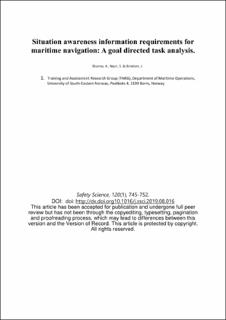| dc.contributor.author | Sharma, Amit | |
| dc.contributor.author | Nazir, Salman | |
| dc.contributor.author | Ernstsen, Jørgen | |
| dc.date.accessioned | 2020-03-12T08:32:16Z | |
| dc.date.available | 2020-03-12T08:32:16Z | |
| dc.date.created | 2019-12-01T12:01:50Z | |
| dc.date.issued | 2019 | |
| dc.identifier.citation | Safety Science. 2019, 120 (1), 745-752. | en_US |
| dc.identifier.issn | 0925-7535 | |
| dc.identifier.uri | https://hdl.handle.net/11250/2646488 | |
| dc.description.abstract | Maritime shipping transports about 90% of the international trade and is considered a high-risk industry. Among all daily operations carried out by merchant ships, navigation is deemed the most critical. With the ever-increasing dimensions of ocean-going ships and the threat possessed by dangerous cargoes in the event of an accident to individual lives and environment alike, the human factors which affect the navigation of merchant ships require paramount consideration to enhance safety in maritime operations. In this study, we explore the concept of Situation Awareness (SA) within the maritime domain, identifying the SA information requirements of navigators and factors affecting their SA. A total of 7 experienced navigators were interviewed in this exploratory study to determine the SA information requirements by a Goal-Directed Task Analysis (GDTA). Three Subject Matter Experts (SMEs) possessing Captain’s license for merchant ships were used for validation of initial findings. The findings reveal the information navigators use during the pilotage phase of navigation and further classify them in three levels. The findings shed light on the factors that affect SA of navigators and are discussed with their potential implications for the procedures and practices which better support SA in maritime navigation. | en_US |
| dc.language.iso | eng | en_US |
| dc.rights | Attribution-NonCommercial-NoDerivatives 4.0 Internasjonal | * |
| dc.rights.uri | http://creativecommons.org/licenses/by-nc-nd/4.0/deed.no | * |
| dc.title | Situation awareness information requirements for maritime navigation: A goal directed task analysis | en_US |
| dc.type | Peer reviewed | en_US |
| dc.type | Journal article | en_US |
| dc.description.version | acceptedVersion | en_US |
| dc.source.pagenumber | 745-752 | en_US |
| dc.source.volume | 120 | en_US |
| dc.source.journal | Safety Science | en_US |
| dc.source.issue | 1 | en_US |
| dc.identifier.doi | 10.1016/j.ssci.2019.08.016 | |
| dc.identifier.cristin | 1755059 | |
| dc.relation.project | EC/H2020/823904 | en_US |
| cristin.ispublished | true | |
| cristin.fulltext | original | |
| cristin.fulltext | postprint | |
| cristin.qualitycode | 1 | |

